The Catholic Church views death as a transition to eternal life, with funeral rites serving as a celebration of faith, hope, and resurrection. These rites, rooted in tradition, provide comfort to mourners while honoring the deceased through prayer, scripture, and the Eucharist, reflecting the Church’s belief in eternal life and the paschal mystery of Christ’s death and resurrection.
Significance of Funeral Rites in Catholic Tradition
The Catholic funeral rites hold profound significance as a celebration of faith, hope, and resurrection. They provide comfort to the grieving by honoring the deceased through prayer, scripture, and the Eucharist. These rites affirm the Church’s belief in eternal life and the paschal mystery of Christ’s death and resurrection. By commending the soul to God’s mercy, the Church strengthens the community’s bond with the deceased and the saints. The rites also remind believers of death’s purpose: a transition to eternal life with God, reflecting the Church’s teachings on dignity, hope, and the ultimate triumph over death;
Theological Understanding of Death and Eternal Life
In the Catholic Church, death is viewed as a transition from earthly life to eternal life, rooted in the Paschal mystery of Christ’s death and resurrection. The Church teaches that death is not an end but a passage to eternal union with God. Funeral rites reflect this belief, offering prayers for the deceased’s soul and comfort for mourners. The Eucharist, central to the Funeral Mass, celebrates Christ’s victory over death, affirming hope in resurrection. This theological framework emphasizes the dignity of human life and the promise of eternal life, grounding the Church’s funeral rites in hope and divine mercy.
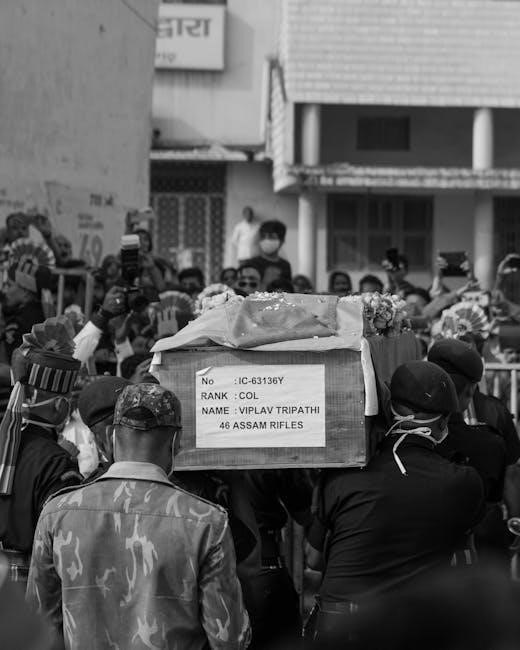
Structure of Catholic Funeral Rites
The Catholic funeral rites are structured into three main parts: the Vigil for the Deceased, the Funeral Mass, and the Rite of Committal, each serving distinct spiritual purposes.
The Vigil for the Deceased
The Vigil for the Deceased is the first part of Catholic funeral rites, typically held in a funeral home or church. It involves prayers, readings, and the Rosary, offering a time for family and friends to gather, share memories, and comfort one another. The Vigil emphasizes prayer for the deceased, seeking God’s mercy and comfort for the mourners. It marks the beginning of the Christian community’s farewell, rooted in hope and resurrection, and prepares all for the Funeral Mass. This rite is a meaningful way to honor the deceased while providing solace to those grieving.
The Funeral Mass
The Funeral Mass is the centerpiece of Catholic funeral rites, celebrating the Eucharist to honor the deceased and comfort mourners. It typically occurs in the parish church, led by a priest, and includes the Introductory Rites, Liturgy of the Word, Eucharistic Sacrifice, and Concluding Rites. The casket is covered with a white pall, symbolizing baptismal garments, and prayers are offered for the deceased’s soul. The Mass affirms the resurrection and eternal life, uniting the deceased with Christ and the Church. It provides solace to the grieving while expressing hope in the promise of eternal life through Christ’s victory over death.
The Rite of Committal
The Rite of Committal marks the final step in Catholic funeral rites, typically held at the gravesite or mausoleum. This brief ceremony includes prayers, a blessing, and the physical burial of the deceased. It serves as a final farewell, entrusting the body to its resting place while affirming hope in resurrection. Family and friends gather to offer last respects, and the rite concludes with a prayer of committal, asking God to receive the deceased into eternal peace. This rite provides closure and comfort, emphasizing the Church’s belief in the dignity of the body as a temple of the Holy Spirit.
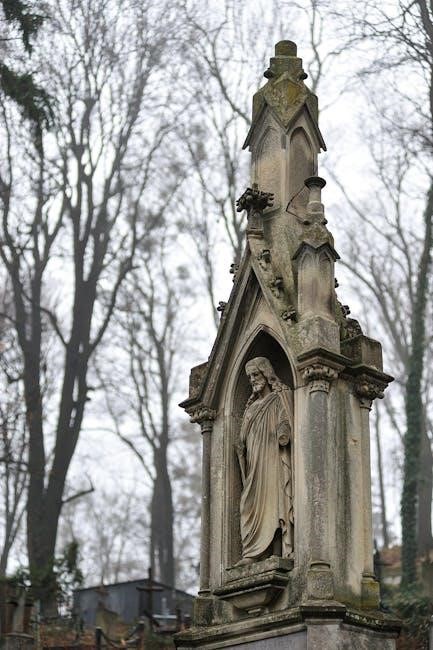
The Vigil for the Deceased
The Vigil for the Deceased, often held in a funeral home or church, is a time for prayer, readings, and eulogies, comforting the family and honoring the deceased.
Prayers and Readings at the Vigil
The Vigil includes prayers for the deceased’s soul and comfort for mourners. Scriptures are read to reflect hope in resurrection, and family or friends may share reflections or eulogies. Traditional prayers, such as the Rosary, are often recited, while other devotions may be included. The service emphasizes God’s mercy and the deceased’s journey to eternal life. These readings and prayers provide solace and reaffirm the Catholic belief in the paschal mystery, helping the community support the grieving while honoring the departed. The Vigil’s intimate nature fosters a sense of unity and shared faith among all present.
Role of Family and Friends in the Vigil Service
Family and friends play a vital role in the Vigil Service, offering emotional and spiritual support. They may participate by placing the pall on the casket, symbolizing baptismal faith, and sharing reflections or eulogies about the deceased. Loved ones are encouraged to lead prayers, such as the Rosary, or read scriptures, fostering a sense of community and shared grief. Their involvement helps honor the deceased while providing comfort to one another. This active participation strengthens bonds and reaffirms faith, creating a meaningful and personal tribute to the departed within the Catholic tradition.
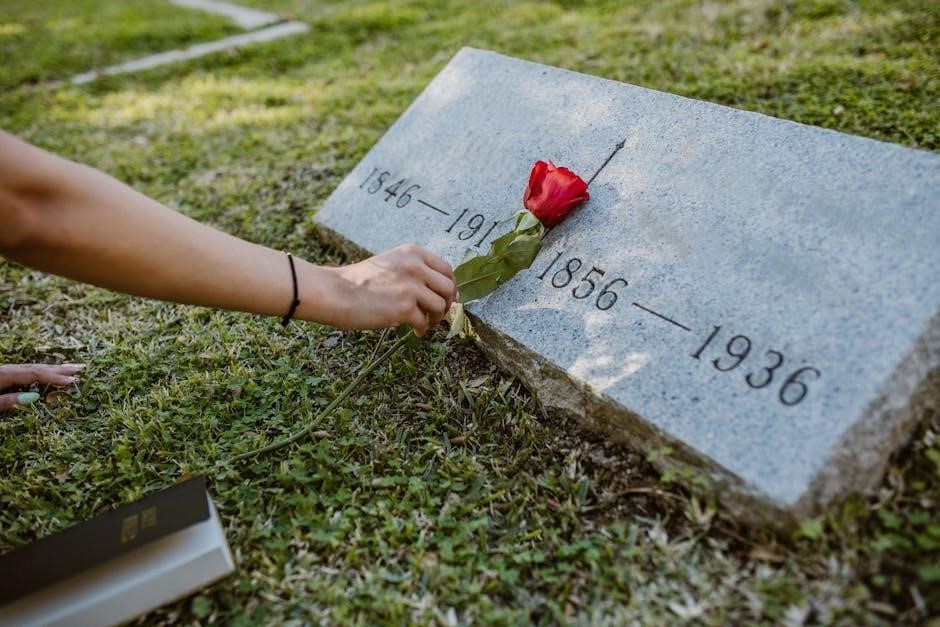
The Funeral Mass
The Funeral Mass is a central sacramental celebration honoring the deceased, offering worship to God and comfort to mourners. It includes the Eucharistic Sacrifice, prayers for the soul, and readings, emphasizing resurrection hope and communal support.
Introductory Rites of the Funeral Mass
Introductory Rites of the Funeral Mass
The Introductory Rites of the Funeral Mass begin with the placement of a white pall on the casket, symbolizing baptismal garments and equality before God. The priest greets the family, and the casket is sprinkled with holy water, recalling baptism. The procession enters the church, led by the cross, symbolizing Christ’s victory over death. The opening prayer invokes God’s mercy and comfort for the mourners, while the casket is incensed to signify purification and prayer rising to heaven. These rites prepare the community to celebrate the Eucharist, offering worship and interceding for the deceased, while expressing hope in resurrection.

Liturgy of the Word at the Funeral Mass
The Liturgy of the Word at the Funeral Mass consists of readings from Scripture, a homily, and the Prayer of the Faithful. The readings, typically from the Old and New Testaments, offer comfort and hope, recalling God’s mercy and the promise of eternal life. The homily reflects on the deceased’s life, connecting it to Christ’s resurrection. The Prayer of the Faithful intercedes for the deceased, their family, and the community, expressing trust in God’s love. This liturgy nourishes faith, consoles mourners, and affirms the hope of resurrection, uniting the assembly in prayer and reflection.
Eucharistic Sacrifice and Communion
The Eucharistic Sacrifice is the heart of the Funeral Mass, where the bread and wine are consecrated into Christ’s Body and Blood. This sacrament re-presents Christ’s sacrifice, offering spiritual nourishment to the mourners and prayers for the deceased. Holy Communion unites the faithful with Christ and the deceased, reinforcing the belief in eternal life. The Rite of Communion may also include prayers for the deceased, seeking God’s mercy and peace. This sacred moment provides comfort and hope, affirming the resurrection and eternal union with God.
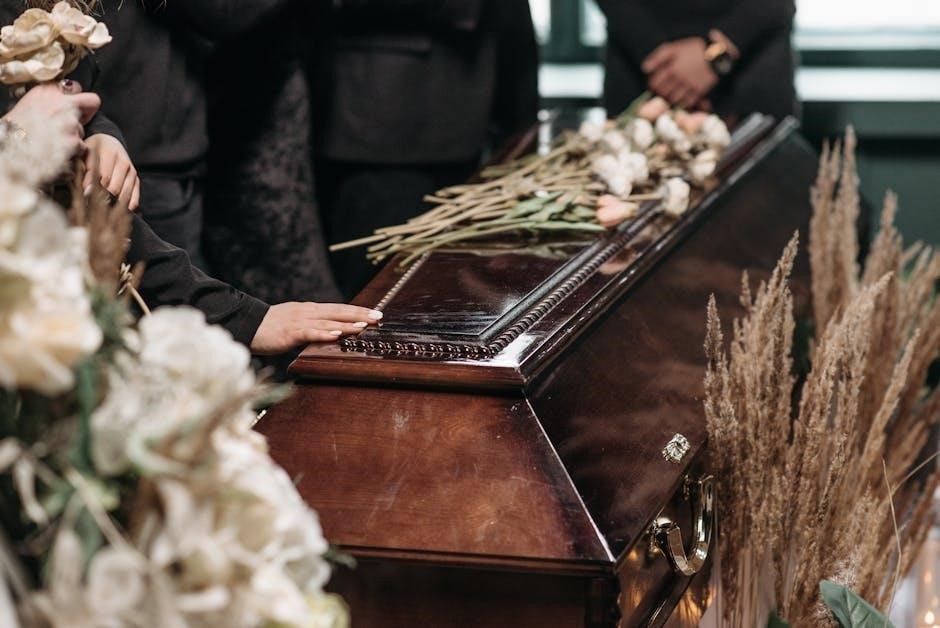
Concluding Rites of the Funeral Mass
The Concluding Rites of the Funeral Mass bring closure to the liturgy while expressing hope in the resurrection. The Final Commendation involves a prayer commending the deceased to God’s mercy, often accompanied by sprinkling with holy water and incensing, symbols of purification and farewell. The Final Blessing is then imparted, offering comfort to the mourners. The rites conclude with the Procession to the church entrance, where the deceased is handed over to the family for burial. These rituals emphasize the Christian hope of eternal life, providing solace and strength to those grieving.
The Rite of Committal
The Rite of Committal is the final step in Catholic funeral rites, involving prayers, blessings, and the physical burial or entombment of the deceased, offering comfort to mourners.
Prayers at the Gravesite or Mausoleum
The prayers at the gravesite or mausoleum are a solemn conclusion to the Rite of Committal, offering blessings and comfort to the grieving. These prayers, often drawn from Scripture and Catholic tradition, are recited to commend the deceased to God’s mercy and to seek peace for those mourning. The rite includes a final blessing over the grave or mausoleum, emphasizing hope in the resurrection and eternal life. This moment provides a sense of closure, uniting the community in faith and comforting those who bid their final farewell to the deceased. The prayers reflect the Church’s belief in eternal life and divine compassion.
Final Farewell and Burial
The final farewell and burial mark the conclusion of the Rite of Committal, where the community gathers to bid a last farewell to the deceased. The coffin is gently placed in the grave or mausoleum, accompanied by prayers and the sprinkling of holy water. A small amount of soil is also placed on the coffin as a symbol of earthly return. This rite emphasizes the Church’s belief in the resurrection and eternal life, offering comfort to mourners. The burial is a sacred moment, reflecting the dignity of the human person and the hope of reunification with the deceased in heaven. The Church permits cremation but requires ashes to be treated with respect, typically buried or placed in a sacred space.
Catholic Funeral Rites and Cremation
The Catholic Church permits cremation but prefers traditional burial, emphasizing respect for the body. Cremated ashes must be buried or placed in a sacred space, not scattered, to honor the deceased’s dignity and faith.
Church’s Stance on Cremation
The Catholic Church permits cremation but prefers traditional burial, as it honors the body’s dignity. Cremation is allowed if it aligns with Christian beliefs, not for motives contrary to faith. Ashes must be buried or placed in a sacred space, such as a cemetery or mausoleum, reflecting respect for the body as a temple of the Holy Spirit. The Church emphasizes that cremation should not diminish the sacredness of funeral rites or the hope of resurrection. This stance balances modern practices with traditional values, ensuring reverence for the deceased and fidelity to Catholic teachings.
Scattering of Ashes and Memorial Services
The Catholic Church discourages the scattering of cremated ashes as it prefers burial or placement in a sacred space, ensuring the body’s dignity is respected. Memorial services are encouraged to honor the deceased, fostering hope and remembrance. These services should reflect Catholic teachings, emphasizing resurrection and eternal life. While scattering is not typically permitted, exceptions may exist under specific circumstances. The Church advocates for reverence in handling remains, aligning with its tradition of honoring the body as a temple of the Holy Spirit. Memorial services provide solace to mourners, reinforcing faith and communal support during bereavement.
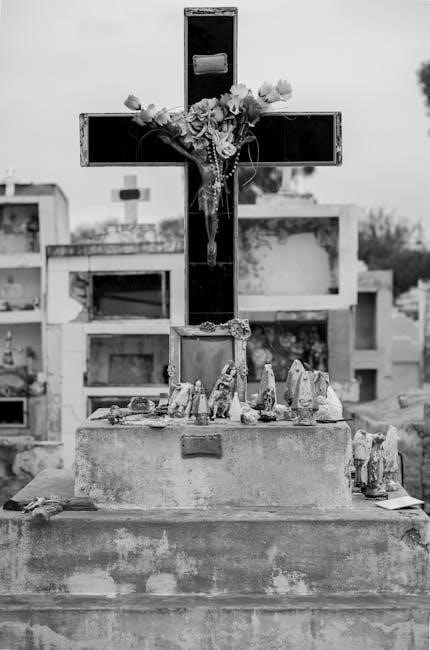
Cultural Variations in Catholic Funeral Rites
The Catholic Church respects and integrates local customs into funeral rites, reflecting the diversity of global cultures while maintaining unity in faith and tradition.
Indigenous Funeral Rites in the Catholic Church
The Catholic Church recognizes and respects indigenous funeral customs, incorporating them into its liturgical practices. These rites often blend traditional rituals with Catholic teachings, reflecting the Church’s universal mission while honoring local cultures. For instance, the Ganda people of Uganda integrate their cultural practices, such as specific chants and community gatherings, into Catholic funeral rites. Similarly, in regions like Siberia and Peru, indigenous traditions are adapted to align with Catholic beliefs, emphasizing the deceased’s journey to eternal life. This integration fosters a sense of unity and cultural identity within the global Catholic community, while maintaining the Church’s theological foundation.
Ganda Funeral Rites and Catholicism
The Ganda people of Uganda have successfully integrated their traditional funeral customs with Catholic teachings, creating a unique blend of cultural and religious practices. Their rites emphasize community participation, with specific chants and rituals that honor the deceased while reflecting Catholic beliefs in eternal life. The Catholic Church supports these practices, viewing them as a way to deepen faith and cultural identity. This harmonious integration highlights the Church’s ability to adapt to diverse traditions while maintaining its theological foundation, ensuring that funeral rites remain meaningful and relevant to the Ganda community’s spiritual and cultural heritage.
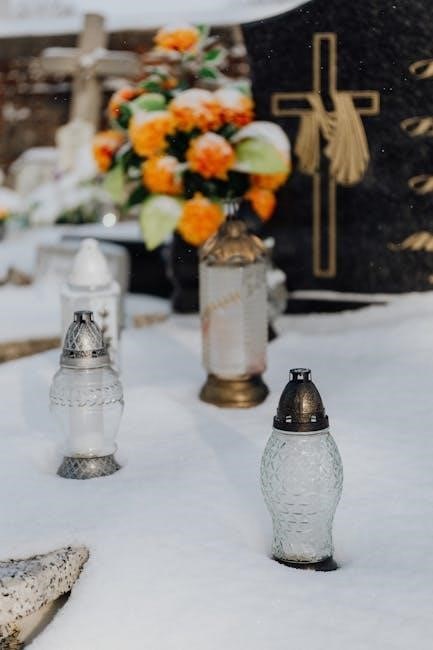
Planning a Catholic Funeral
Planning a Catholic funeral involves selecting prayers, readings, and music while adhering to Church guidelines. Guides and parish support help families make meaningful choices for a dignified service.
Guide to Planning Funeral Rites
Planning a Catholic funeral involves thoughtful preparation, guided by Church traditions and personal preferences. Families can use a funeral guidebook to select scripture readings, prayers, and sacred music suitable for the liturgy. The parish liturgy coordinator assists in choosing appropriate hymns and readings, ensuring they align with Catholic worship norms. The process includes meeting with the funeral facilitator, completing planning forms, and discussing the sequence of rites. This structured approach helps create a meaningful and dignified celebration, comforting mourners while honoring the deceased. The guide emphasizes the importance of reflecting the deceased’s faith journey and the Church’s teachings on eternal life.
Choosing Music for the Funeral Mass
Music plays a vital role in the Catholic Funeral Mass, serving as a means to express faith, hope, and consolation. Hymns and chants should be selected in accordance with Catholic liturgical guidelines, ensuring they are suitable for worship and reflect the Church’s teachings on resurrection and eternal life. The U.S. Bishops’ document “Sing to the Lord” provides criteria for choosing sacred music. Families, in consultation with the parish liturgy coordinator, select music that honors the deceased while uplifting the assembly. The chosen songs should foster prayerful participation and embody the Church’s belief in the paschal mystery, offering comfort to mourners and glorifying God;
Selecting Readings and Prayers
Selecting appropriate readings and prayers for a Catholic funeral is a meaningful way to honor the deceased and reflect their faith journey. The Order of Christian Funerals provides options for three readings: one from the Old Testament, one from the Epistles, and a Gospel reading. These selections should resonate with themes of resurrection, hope, and eternal life. Families are encouraged to participate in choosing these readings, often with guidance from the parish. Prayers, such as the Prayer of the Faithful, are tailored to the deceased and their family, while the Final Commendation prayer offers a heartfelt farewell, entrusting the soul to God’s mercy and love.

Role of the Parish in Funeral Rites
The parish plays a vital role in supporting families through funeral rites, offering liturgical guidance, spiritual comfort, and practical assistance in planning and coordinating the ceremonies.
Support from the Parish Community
The parish community plays a vital role in providing emotional and spiritual support during funeral rites. Members often participate in the vigil service, offering prayers and consolation to the grieving family. The parish may also assist with practical arrangements, such as coordinating the Funeral Mass and Rite of Committal. Through their presence and involvement, the community embodies Christ’s compassion and reinforces the belief in eternal life. This collective support helps the family navigate their loss with faith and hope, reminding them they are not alone in their sorrow.
Parish Liturgy Coordinator’s Role
The Parish Liturgy Coordinator plays a crucial role in guiding the planning and execution of Catholic funeral rites. They ensure that the liturgy aligns with Catholic traditions and liturgical guidelines, providing support to the family in selecting appropriate readings, prayers, and music. The coordinator collaborates with the priest, funeral directors, and the parish community to create a dignified and meaningful celebration. They also assist in preparing the worship space and coordinating the participation of altar servers, lectors, and musicians. Their role ensures that the funeral rites reflect the Church’s teachings on eternal life and resurrection, offering comfort and hope to the grieving family.

Historical Evolution of Catholic Funeral Rites
Catholic funeral rites trace their roots to ancient traditions, evolving over centuries. The Church incorporated early Christian practices, formalized in the Middle Ages, and refined them through Vatican II reforms. Modern rites balance tradition with contemporary needs, reflecting the Church’s enduring commitment to honoring the deceased and comforting the living through liturgical celebration and prayer.
Traditional vs. Modern Practices
The Catholic Church has balanced the preservation of ancient traditions with adaptation to contemporary needs. Historically, funeral rites were deeply rooted in the Tridentine Mass and strict burial customs. Modern practices, influenced by Vatican II, emphasize simplicity and accessibility, such as the use of vernacular languages. The Church now permits cremation, reflecting changing societal norms. While traditional rites often featured elaborate ceremonies, today’s practices focus on clarity and participation, ensuring the liturgy remains meaningful. These shifts maintain the Church’s commitment to honoring the deceased while resonating with modern Catholics, blending timeless theology with cultural sensitivity.
Recent Reforms in Papal Funeral Rites
Recent reforms in papal funeral rites reflect Pope Francis’s emphasis on simplicity and faith in the risen Christ. The Vatican updated the liturgical book, Ordo Exsequiarum Romani Pontificis, to streamline rituals, focusing on spiritual significance over elaborate ceremonies. The reforms include fewer pompous processions and a greater emphasis on prayer and mercy. These changes align with Francis’s desire to reflect humility and the Church’s mission of evangelization. The rites now prioritize the universal Church’s participation, ensuring a more intimate and theologically profound celebration of the pope’s life and transition to eternal rest.
Funeral Rites for Popes
Funeral Rites for Popes
Papal funerals are uniquely solemn, reflecting the pope’s role as the Church’s spiritual leader. The rites include a formal declaration of death, prayers, and a conclave to elect a successor, blending tradition with the transition of spiritual authority.
Unique Aspects of Papal Funerals
Papal funerals are distinguished by their solemnity and unique traditions. The rites begin with a formal declaration of the pope’s death, followed by prayers and the Ring of St. Peter being broken. Cardinals gather for the conclave to elect the successor, while the funeral itself is a global event. Pope Francis simplified his funeral rites to reflect humility and focus on faith in the risen Christ. The ceremonies, held in St. Peter’s Basilica, emphasize the pope’s role as a spiritual leader, blending ancient traditions with the Church’s transition of authority, offering a profound expression of mourning and hope for the faithful worldwide.
Significance of Simplified Rites
The simplification of papal funeral rites underscores the Catholic Church’s emphasis on humility and faith over elaborate ceremonies. Pope Francis’s reforms reflect a desire to focus on the spiritual essence of the rites, aligning with his vision of a Church rooted in simplicity and service. By streamlining the rituals, the Church highlights the universal message of resurrection and eternal life, reminding the faithful that death is a natural part of life. This shift also symbolizes the Church’s commitment to equality and its rejection of worldly pomp, reinforcing the belief that all believers, regardless of rank, are united in Christ’s paschal mystery.
Catholic funeral rites conclude with dignity, offering hope and support to the grieving, while reaffirming belief in eternal life and the resurrection of Christ, embodying the Church’s enduring faith and compassion.
Importance of Funeral Rites in Catholic Faith
The Catholic funeral rites are integral to the faith, offering a profound expression of worship, comfort, and hope. They affirm the Church’s belief in eternal life, uniting the deceased with God and the communion of saints. These rites provide solace to mourners, emphasizing resurrection and divine mercy. The Eucharistic celebration strengthens the community’s bond and intercedes for the deceased’s soul. The rites also uphold the dignity of the human person, created in God’s image, and reflect the Church’s commitment to prayerfully accompanying the deceased on their final journey. They are a testament to faith, love, and the promise of eternal life.
Final Thoughts on Dignity and Hope
Catholic funeral rites embody profound dignity and hope, reflecting the Church’s belief in eternal life. These rituals honor the deceased with prayer, scripture, and the Eucharist, offering comfort to mourners. The rites affirm the dignity of human life, created in God’s image, and provide hope in Christ’s resurrection; They remind the faithful of eternal life’s promise and the communion of saints. The Church’s liturgy supports the grieving while celebrating the deceased’s life and faith. Ultimately, Catholic funeral rites are a testament to hope, reinforcing the belief in a final reunion with God and loved ones in eternal life.